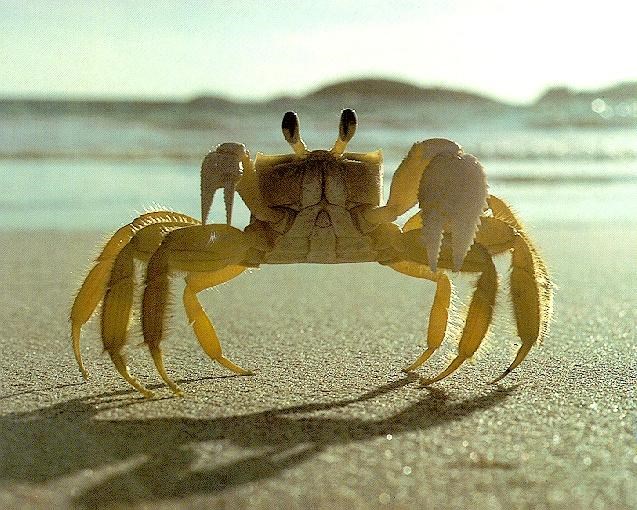In Texas, animal or plant species of conservation concern may be listed as threatened or endangered under the authority of state law and/or under the U.S. Endangered Species Act. Species may be listed as state threatened or endangered and not federally listed. The state list deals only with the status of the species within Texas. A federal listing means that an animal is in decline throughout its entire range which may encompass several other states or nations. This series includes wildlife which may be close to extinction and is comprised of birds, fish, invertebrates, mammals, plants, amphibians and reptiles.
Fiddler Crab (Uca rapax)

Description: The fiddler crab's carapace (shell) length is 1 to 2 inches (2.5 to 5 cm). It is dark during the day; turning a lighter color at night. Males have one large claw and one small claw. Females' claws are the same size. Fiddler crabs move sideways rather than forward or backward.
Life History: Algae, bacteria, fungus scraped off of sand particles, and detritus (dead and decaying plant and animal matter) form the bulk of the fiddler crab's diet. Predators that feed on fiddler crabs include herons, egrets and raccoons. At one to two years, the fiddler crab reaches sexual maturity. Spawning season is from June through August. Eggs incubate for 14 days before hatching. Fiddler crabs live up to 1.5 years.
Fiddlers have a remarkable mating ritual: male fiddlers line up beside the tidy burrows they have dug and move their chelipeds (large claws) back and forth in a fiddling motion to attract females. Females, fresh from foraging, will walk past and if a male catches a female's eye, he will tap the ground with his claw. If she is still receptive to his advances, she will enter his burrow. They mate inside the burrow and she emerges two weeks later to release her sponge (fertilized eggs) into the water.
The burrows provide privacy for mating, sleeping and "hibernating" during the winter months. Fiddlers also burrow into the sand to escape from predators and abandon their temporary burrow once the danger has passed. During high tide, fiddler crabs pack sand into the entrance to their burrows and wait until the tides goes down again. Sand or mud pellets "sprinkled" around the opening of a crab burrow means that a crab lives there.
Fiddler crabs reabsorb their shells rather than shedding them as they grow. Fiddlers use their claws to pick up sediment and scrape food particles into their mouths. The males can only use their single small claw for feeding so they have to work twice a hard as the females do to get the same nutrients. If one claw is lost, the fiddler crab will soon regenerate (regrow) a new one. In the meantime, the remaining claw will grow bigger. These crabs are seen year-round in Texas salt marshes and are always moving sideways.
Habitat: Fiddler crabs are most often found in soft sand or mud near or around the edges of shallow salt marshes.
Distribution: Fiddler crabs can be found from the Gulf of Mexico to South America.
Other: Fiddler crabs are the most common crab in a salt marsh and they play an important role in the salt marsh community. They eat detritus (dead or decomposing plant and animal matter) and are themselves food for a number of wetland animals. In Spanish, the fiddler crab is called a cangrejo violinista, which literally translates to "violinist crab". Fiddler crabs help preserve our important coastal wetland ecosystems. By burrowing deep into the mud of the marshes, the crabs create a maze of tunnels that aerate (add oxygen to) the marsh grasses and underwater seagrass meadows.
Because this series is quite a distance from my house, maintenance is rather difficult. Log's get wet, containers break, and sometimes caches just flat go missing. If you dont find the cache, and believe it to be gone, or it needs maintenance, please feel free to make it whole again. As a thank you, you may add a second log to any that you do maintenance on. And thanks for the help.